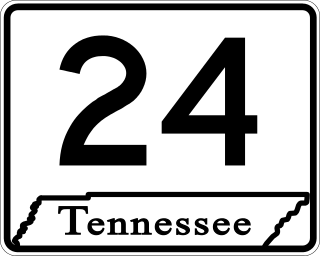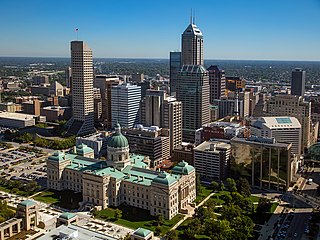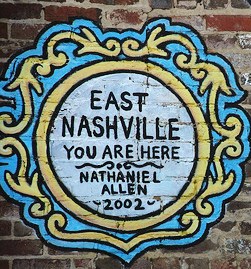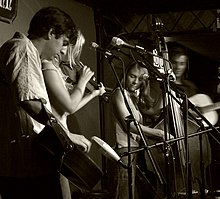
Nashville, often known as Music City, is the capital and most populous city in the U.S. state of Tennessee and the county seat of Davidson County. Located in Middle Tennessee, it had a population of 689,447 at the 2020 U.S. census. Nashville is the 21st most populous city in the United States, and the fourth most populous city in the southeastern U.S. Located on the Cumberland River, the city is the center of the Nashville metropolitan area, and is one of the fastest growing in the nation.

Interstate 24 (I-24) is an Interstate Highway in the Midwestern and Southeastern United States. It runs diagonally from I-57, 10 miles (16 km) south of Marion, Illinois, to Chattanooga, Tennessee, at I-75. It travels through Illinois, Kentucky, Tennessee, and Georgia. As an even-numbered Interstate, it is signed as an east–west route, though the route follows a more southeast–northwest routing, passing through Nashville, Tennessee. The numbering deviates from the standard Interstate Highway System grid, lying further north than its number would indicate west of Nashville. The short segment within Georgia bears the unsigned designation State Route 409 (SR 409).

Interstate 40 (I-40) is a major east–west transcontinental Interstate Highway in the southeastern and southwestern portions of the United States. At a length of 2,556.61 miles (4,114.46 km), it is the third-longest Interstate Highway in the country, after I-90 and I-80. From west to east, it passes through California, Arizona, New Mexico, Texas, Oklahoma, Arkansas, Tennessee, and North Carolina. Its western terminus is at I-15 in Barstow, California, while its eastern terminus is at a concurrency with U.S. Route 117 (US 117) and North Carolina Highway 132 (NC 132) in Wilmington, North Carolina. Major cities served by the interstate include Flagstaff, Arizona; Albuquerque, New Mexico; Amarillo, Texas; Oklahoma City, Oklahoma; Little Rock, Arkansas; Memphis, Nashville, and Knoxville in Tennessee; and Asheville, Winston-Salem, Greensboro, Durham, Raleigh, and Wilmington in North Carolina.

Mt. Juliet is a city located in western Wilson County, Tennessee, United States. A suburb of Nashville, it is approximately 17 miles (27 km) east of downtown Nashville. Mt. Juliet is located mostly between two major national east-west routes, Interstate 40 and U.S. Route 70. As of the 2020 United States census, Mount Juliet has a population of approximately 39,289 people. Mt. Juliet is the largest city in Wilson County. The official city charter has the name listed as Mt. Juliet; however, the United States Postal Service lists its name as Mount Juliet.
Green Hills is an affluent neighborhood in Nashville, Tennessee, United States. Green Hills is located south of downtown Nashville on Hillsboro Pike.

State Route 24 is an unsigned west–east state highway in Tennessee, as it coincides with U.S. Route 70 and U.S. Route 70N for its entire duration from Nashville to Crossville. The road begins in western Nashville and ends in Crossville. It runs alongside Interstate 40 for its entire length.
WTVF is a television station in Nashville, Tennessee, United States, affiliated with CBS. It is owned by the E. W. Scripps Company alongside Ion Television owned-and-operated station WNPX-TV. WTVF's studios are located on James Robertson Parkway in downtown Nashville, and its transmitter is located north of downtown along I-24 near Whites Creek.

The 16th Street Mall is a pedestrian and transit mall in Denver, Colorado that opened in 1982. The mall, 1.25 miles long, runs along 16th Street in downtown Denver, from Wewatta Street to the intersection of 16th Avenue and Broadway. The intricate granite stone sidewalks and streets were designed by architect I.M Pei to resemble the scale pattern of the western diamondback rattlesnake. It is home to over 300 stores, 50 restaurants, and the Denver Pavilions shopping mall. In April 2022, construction started on a $149-million multi-year rebuild of the 40-year-old infrastructure, expected to finish in late 2024.
This article pertains to the history of Nashville, the state capital of Tennessee. What is now Nashville was the center of civilization for the Mississippian culture around 1300. In 1779, Fort Nashborough was built here in 1779 by pioneers from North Carolina. In 1784 it was incorporated as a town by the North Carolina legislature. The Southwest Territory became the state of Tennessee in 1796 and Nashville became an incorporated city in 1806. In 1843 it became the state capital of Tennessee. In the Civil War Nashville was seized by Federal troops in 1862 and became a major Union military base. Confederate General J. B. Hood was decisively defeated in the Battle of Nashville in 1864. The city became the political, transportation, business and cultural center of the Middle Tennessee region. Besides the state government, it is best known for its educational, musical and religious establishments. In 1963 Nashville and Davidson County were consolidated under a single charter and are administered by a mayor and a council.
WQQK is an urban adult contemporary radio station broadcasting in the Nashville, Tennessee. Its transmitter site is in Goodlettsville, Tennessee, and its studios are located in Nashville's Music Row district.

WCJK is a commercial radio station licensed to Murfreesboro, Tennessee and serving the Nashville metropolitan area. It airs an adult hits radio format and is owned by Midwest Communications, Inc. It subscribes to the nationally syndicated Jack FM service.

The Nashville metropolitan area is a metropolitan statistical area in north-central Tennessee. Its principal city is Nashville, the capital of and largest city in Tennessee. With a population of over 2 million, it is the most populous metropolitan area in Tennessee. It is also the largest metropolitan area in Tennessee in terms of land area.

Downtown Indianapolis is a neighborhood area and the central business district of Indianapolis, Indiana, United States. Downtown is bordered by Interstate 65, Interstate 70, and the White River, and is situated near the geographic center of Marion County. Downtown has grown from the original 1821 town plat—often referred to as the Mile Square—to encompass a broader geographic area of central Indianapolis, containing several smaller historic neighborhoods.

Downtown Columbus is the central business district of Columbus, Ohio. Downtown is centered on the intersection of Broad and High Streets, and encompasses all of the area inside the Inner Belt. Downtown is home to most of the tallest buildings in Columbus.

Downtown Paterson is the main commercial district of Paterson, Passaic County, in the U.S. state of New Jersey. The area is the oldest part of the city, along the banks of the Passaic River and its Great Falls. It is roughly bounded by Interstate 80, Garret Mountain Reservation, Route 19, Oliver Street, and Spruce Street on the south; the Passaic River, West Broadway, Cliff Street, North 3rd Street, Haledon Avenue, and the borough of Prospect Park on the west; and the Passaic River also to the north.

100 Oaks Mall is a shopping mall located three miles south of downtown Nashville, Tennessee along Interstate 65 and Tennessee State Route 155. Neighborhoods and cities around the area include Berry Hill, Woodbine and Oak Hill.

East Nashville is an area east of downtown Nashville in Tennessee across the Cumberland River. The area is mostly residential and mixed-use areas with businesses lining the main boulevards. The main thoroughfares are Gallatin Ave and Ellington Parkway, with smaller arteries interconnecting the neighborhoods. Some of these smaller arteries include Main Street, Shelby Avenue, Porter Road, Riverside Drive, Eastland Avenue, McFerrrin Avenue, and Woodland Street in no significant order. Ellington Parkway, which parallels Gallatin Ave and Main Street, bypasses I-24 and I-65 and connects Briley Parkway and downtown Nashville and many other secondary streets along the way. The Cumberland River confines most of the area with a semicircle design on the south, southwest and east. Since East Nashville has no defined boundaries on the west and north the exact perimeter is the cause of some debate. Some would say that Ellington Parkway creates a boundary on the west and northwest, while Cahal Avenue and Porter Road create the northern boundary, in the confines of zipcode 37206. Many would also state that with I-65 and I-24 as the western border and Briley Parkway as the northern boundary, this defines an area that constitutes Greater East Nashville. East Nashville is one of about 26 suburban neighborhoods in Nashville.
The following is a timeline of the history of the city of Nashville, Tennessee, United States.

Mount Vernon Triangle is a neighborhood and community improvement district in the northwest quadrant of Washington, D.C. The neighborhood is located adjacent to Mount Vernon Square. Originally a working-class neighborhood established in the 19th century, present-day Mount Vernon Triangle experienced a decline in the mid-20th century as it transitioned from residential to commercial and industrial use.
Jefferson Street is a street in Nashville, Tennessee, U.S., which developed as the historic center of the city's African-American community. Three historically black universities are located near here: Fisk University, Meharry Medical College and Tennessee State University. In the 1940s-1960s, it attracted many rock and roll as well as rhythm and blues artists. It was a center for the Nashville sit-ins in the 1960s, but the construction of Interstate 40 across the street in 1968 led to its economic decline. Since 2011, Lorenzo Washington and his staff at the Jefferson Street Sound Museum, the neighborhood community music museum is conserving the musical legacies of the 1940s through 1970s.














